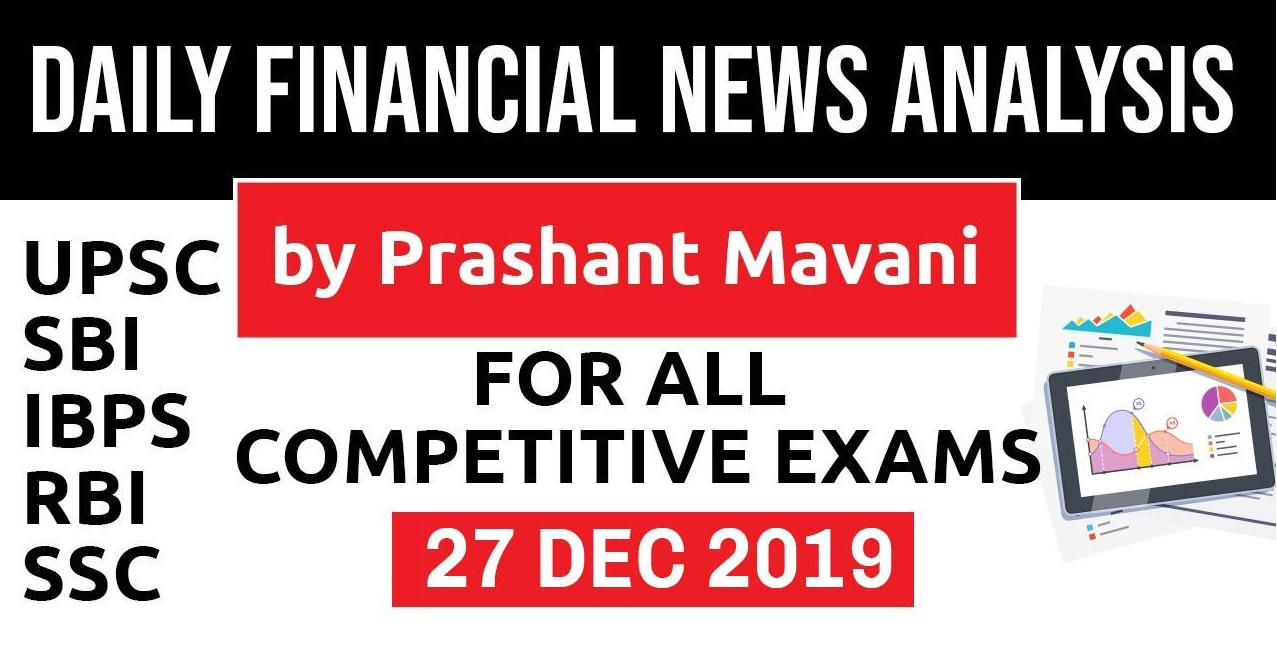Table of Contents
FM to meet heads of PSBs
- December 28
- A. To discuss the credit flow to micro, small and medium enterprises (MSMEs)
- B. The status of IBC cases
- In September, Sitharaman asked banks not to declare stressed MSME loans as NPAs till March 2020.
- The government wants to review the progress following various steps taken by it in recent past.
- This meeting is taking place at a time when banks have been referring unresolved stressed companies to the National Company Law Tribunal (NCLT).
- The successful resolution of Essar Steel has encouraged banks to take the IBC route.
- Banks have also come under regulatory scanner due to lapses in corporate governance.
FCI
- Food Corporation of India’s (FCI) grain stocks level is now close to its capacity of 76 million tonne (MT).
- Given the expected pace of off-take under PDS and other schemes, it might face a storage crisis over the next two-three months and be compelled to sell a large surplus in the open market.
- This could potentially inflate the food subsidy bill, as open market sales would likely be below the economic cost of grains and loss-making.

- It may be noted that FCI is facing a storage problem when its stock levels are far higher than the buffer levels.
- Its rice stocks, for instance, is now a little over 21 MT whereas the buffer requirement as on January 1 is 7.6 MT.
- Economic cost of wheat is about Rs 25/kg and rice is Rs 36/kg for the current year, and storage accounts for 15% of this.
G-secs via OMOs
- Operation Twist: simultaneous purchase and sale of long-tenor and short-tenor government securities respectively worth Rs 10,000 crore each.
- The open market operations (OMOs) will be the second in the series as was expected by market participants who anticipate at least Rs 50,000 crore of OMOs.
- The central bank is again targeting the 10-year benchmark bonds or the 6.45% yielding notes maturing in 2029 by deciding to purchase Rs 10,000 crore of the papers thereby reducing their supply in the market.
- The RBI is looking to sell short-dated securities maturing in 2020 worth Rs 10,000 crore.
Renewable Energy Push
- India is all set to cross the 100-GW renewable energy capacity mark in 2020.
- It can make rapid strides towards the ambitious 175-GW clean energy target by 2022.
- Provided the government keeps a close eye on key issues and deals with those well in time.
- The government however needs to promote storage to ensure 24×7 clean energy supply as coal-fired thermal power still remains the base load in the country.

- Overdue amount of discoms toward generators
- Conventional: Rs 65,000 crore
- Non-conventional: Rs 5,590 crore
- Earlier this year, several new programs such as PM-KUSUM, solar rooftop Phase-2, development of ultra mega renewable energy power parks (UMREPPs), etc have been introduced to promote renewable energy sector in India.

FAO
- Food & Agriculture Organisation:
- Select agri and agri-based commodities like meat, milk and fruits, among others, present export opportunity worth over USD 97 billion (about Rs 6.9 lakh crore) for India.
- India’s export share in agri items such as bananas, oranges, chicken, meat, and milk products like cheese and butter milk is miniscule at present.
- World Trade Centre: in 2017 the country’s share in the global market for
- 19 commodities was a miniscule 1.5 per cent, or around USD 1.5 billion (about Rs 10,650 crore).
- Potential: USD 97 billion
- It can be noted that nearly a third of Indian farm produce is wasted due to lack storage/proper transport facilities.
Good Governance Index
- GGI was launched by the central government to assess the state of governance in the country.
- The objectives of GGI are to provide quantifiable data to compare the state of governance in all states and Union territories.
- Enable them to formulate and implement suitable strategies for improving governance and shift to result oriented approaches and administration.
- Various principles have been kept in mind while selecting the indicators, i.e. it should be easy to understand and calculate, citizen-centric and result driven, leading to improved results and applicable to all states and UTs, among others, it said.
- The GGI takes into consideration 10 sectors — agriculture and allied sectors, commerce and industries, human resource development, public health, public infrastructure and utilities, economic governance, social welfare & development, judicial and public security, environment and citizen-centric governance.
- The states and UTs are divided into three groups — big states, north-east and hill states, and Union territories.
- Minister of State for Personnel Jitendra Singh launched the ‘good governance index’ at an event organised by the Ministry of Personnel, Public Grievances & Pensions on the occasion of good governance day here.
- The good governance day is observed on the birth anniversary of former prime minister Atal Bihari Vajpayee.
Download Free PDF























 WhatsApp
WhatsApp